An In-Depth Exploration of Autism Subtypes and Classifications
Autism spectrum disorder (ASD) encompasses a wide range of neurodevelopmental conditions characterized by challenges in social communication, repetitive behaviors, and cognitive differences. Once thought of as separate disorders, conditions like autistic disorder, Asperger's syndrome, and PDD-NOS are now unified under the umbrella of ASD, reflecting the spectrum's vast diversity. This article aims to clarify the different types and classifications of autism, examine their characteristics and presentation variations, explore the evolution of diagnostic criteria, and discuss the latest scientific discoveries that shed light on the underlying genetics and implications for personalized treatment approaches.
Historical and Current Classifications of Autism Spectrum Disorders
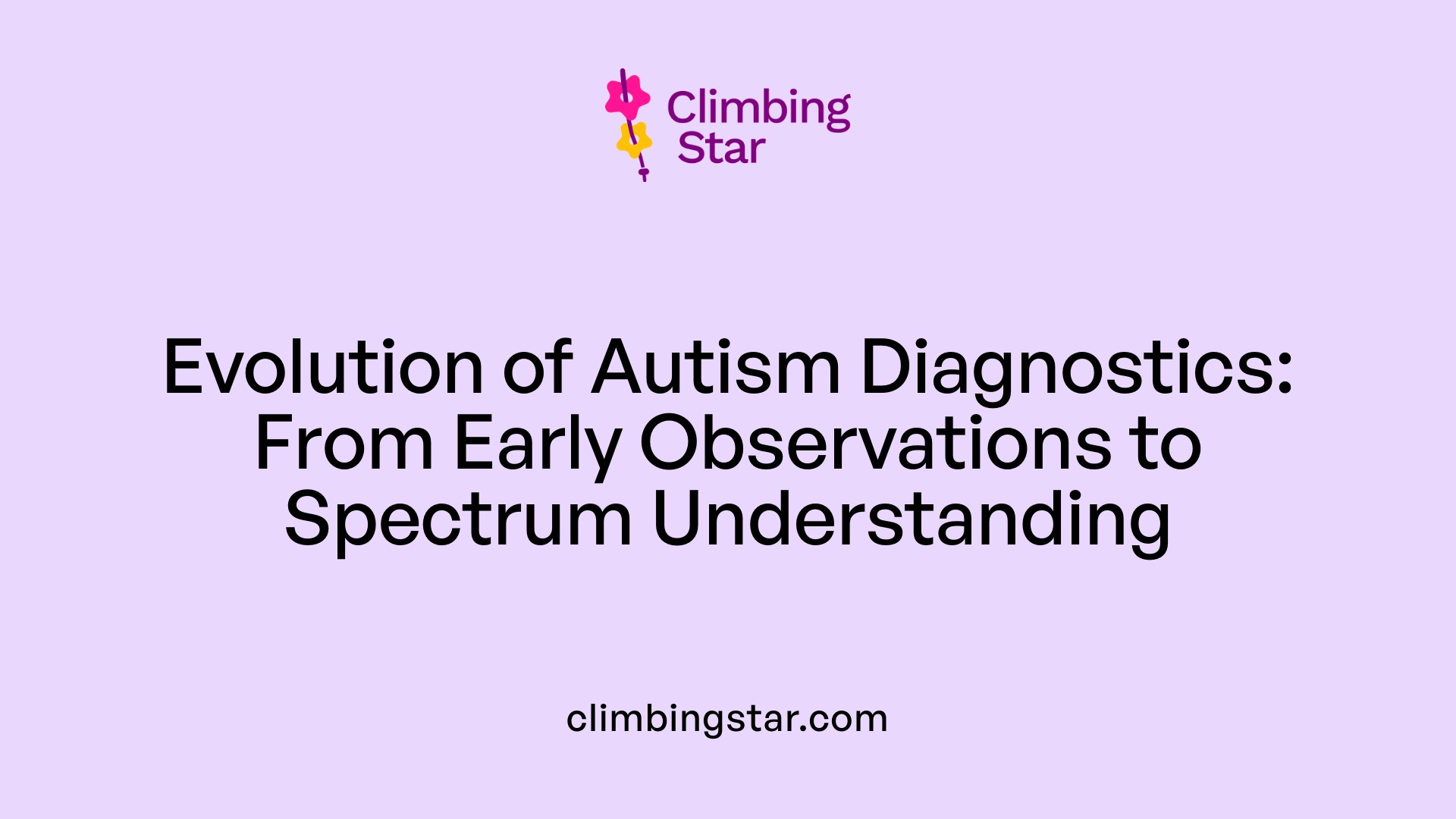
How has the development of autism diagnostic criteria evolved over time?
The understanding and classification of autism spectrum disorders (ASD) have significantly changed over the decades. Originally, the diagnosis was based on clinical observations with broad and often inconsistent criteria.
In the early DSM editions, terms like 'Kanner’s Syndrome' and 'childhood autism' emerged. These were primarily focused on young children displaying intense social and communication challenges along with repetitive behaviors. As research advanced, other conditions such as Asperger’s syndrome, PDD-NOS, and childhood disintegrative disorder were identified, each with particular features.
Over time, the diagnostic criteria expanded and refined. The DSM-IV distinguished several separate disorders within the autism spectrum, including autistic disorder, Asperger’s disorder, and PDD-NOS, each with specific criteria.
The publication of DSM-5 in 2013 marked a major shift. It unified these conditions under the umbrella term "autism spectrum disorder" (ASD).
This change aimed to improve diagnostic consistency and reflect the overlapping features among these conditions. DSM-5 introduced a tiered support system, categorizing severity into three levels:
| Level 1 | Requiring support |
|---|---|
| Level 2 | Requiring substantial support |
| Level 3 | Requiring very substantial support |
This classification emphasizes individual needs and guides intervention strategies.
How are previous conditions now included under ASD in DSM-5?
Conditions like autistic disorder, Asperger’s syndrome, and PDD-NOS are now encompassed within ASD. This broader grouping recognizes the spectrum of presentations rather than viewing them as distinct diagnoses.
- Autistic disorder involved significant impairments in communication and social interactions, along with repetitive behaviors.
- Asperger’s syndrome was characterized by few or no delays in language or cognitive development, often considered on the milder end.
- PDD-NOS (Pervasive Developmental Disorder-Not Otherwise Specified) was used for individuals with some autism signs but not meeting full criteria for specific disorders.
The reclassification has helped to streamline diagnosis and acknowledge the wide variability among individuals.
What are the differences in terminology and classification systems?
The terminology has evolved to reflect an improved understanding of autism’s diversity. Key differences include:
| System | Terminology | Focus | Notable Features |
|---|---|---|---|
| DSM-II / ICD-9 | Autistic disorder, childhood autism | Discrete categories | Less emphasis on spectrum, more distinct diagnoses |
| DSM-IV | Autism, Asperger’s syndrome, PDD-NOS, Childhood disintegrative disorder | Separate disorders | Recognized variability but still separate entities |
| DSM-5 / ICD-11 | Autism spectrum disorder | Spectrum approach | Unified diagnosis, severity levels, personalized intervention |
While older classifications emphasized distinctions, current systems recognize the broad range of presentations within a single spectrum. This approach allows for more tailored support and better reflects the neurodevelopmental diversity.
Final overview of autism spectrum disorder subtypes and their classification changes
| Classification | Former Term | Common Characteristics | Current Severity Levels | Notes |
|---|---|---|---|---|
| Autism Spectrum Disorder | Autistic disorder | Social communication challenges, repetitive behaviors | Level 1-3 | Most comprehensive current diagnosis |
| Autism Spectrum Disorder | Asperger’s syndrome | No significant language delay, focused interests | Seen as Level 1 or unclassified | Still used colloquially |
| Autism Spectrum Disorder | PDD-NOS | Less specific symptoms, milder | Integrated as part of ASD | Reclassified for consistency |
| Other Disorders | Rett syndrome, Childhood disintegrative disorder | Severe regression, genetic causes | Not classified under ASD | Different origins and characteristics |
By understanding these historical to modern shifts, clinicians can better appreciate the complexity of autism diagnosis and tailor care accordingly.
Understanding Autism Spectrum Disorder (ASD): Definitions and Core Features
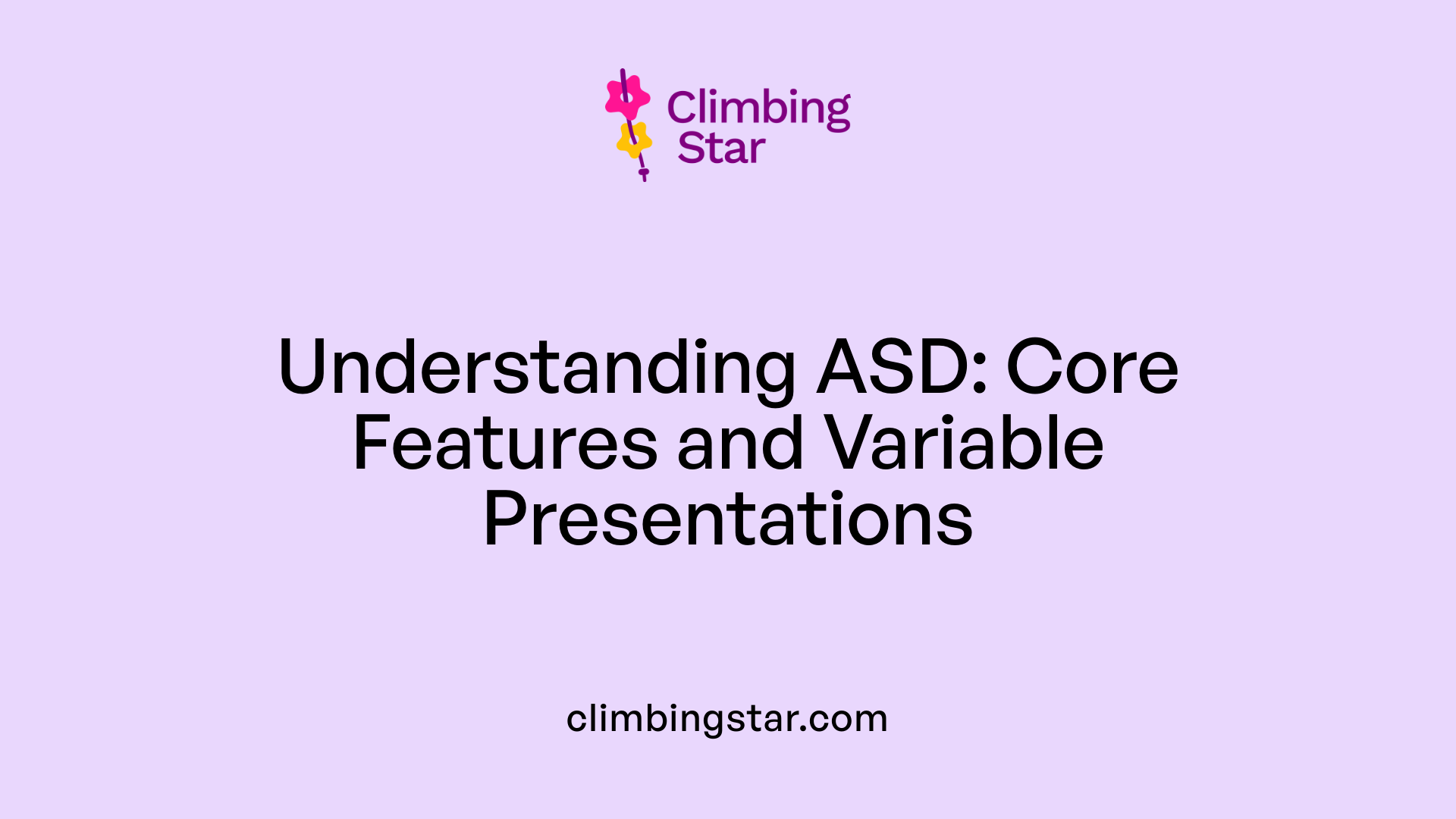
What are the common signs and symptoms of autism spectrum disorders, and how do their presentations vary?
Autism Spectrum Disorder (ASD) encompasses a wide range of social, communication, and behavioral challenges that can look very different from person to person. Recognizing these signs can help in early detection and support.
Children with ASD often find social interactions challenging. They might avoid eye contact, have limited gestures, and find it hard to share interests or emotions with others. Many do not respond when their name is called or may seem indifferent to social cues.
Communication issues are common, ranging from being nonverbal to speaking normally but struggling with understanding tone or nuance. Repetitive behaviors are also typical, such as hand-flapping, rocking, lining up toys, or insisting on routines. Some individuals focus intensely on specific objects or topics, demonstrating fixated interests.
The severity of symptoms varies significantly.
| Severity Level | Typical Characteristics | Additional Notes |
|---|---|---|
| Mild (Level 1) | May require some support; subtle social challenges | Often referred to as high-functioning autism; individuals may develop language skills normally |
| Moderate (Level 2) | Marked social and communication difficulties; need substantial support | Challenges may impact daily routines & social relationships |
| Severe (Level 3) | Severe impairments; minimal verbal skills; substantial support needed | Significant impact on daily life; may have co-occurring intellectual disabilities |
These differences mean ASD can manifest in many ways, sometimes with subtle signs that are overlooked until later years. Early diagnosis and intervention can help improve outcomes by addressing specific challenges.
Typical signs often appear between ages 2 and 3, although some symptoms may be evident in infancy. Children with ASD may display challenges such as:
- Limited eye contact
- Not responding to their name
- Preference for playing alone
- Repetitive movements
- Strict routines
- Intense interests in specific objects or topics
Furthermore, each person with ASD is unique, with some being nonverbal or minimally verbal, while others speak normally but find social engagement difficult. The spectrum also includes individuals with and without intellectual disabilities, adding to its diversity.
How Characteristics and Co-occurring Conditions Vary
Many individuals with ASD experience additional conditions, impacting their development and daily functioning. Common co-occurrences include ADHD, anxiety, depression, gastrointestinal issues, seizures, and sleep disorders.
Understanding these variable features allows caregivers, educators, and healthcare professionals to tailor interventions that meet each person’s specific needs.
Summarizing the Range of Autism Presentations
The broad nature of ASD is best summarized in this table:
| Aspect | Variations | Description |
|---|---|---|
| Social Skills | Limited, typical, or advanced | Includes eye contact, gestures, sharing, and social reciprocity |
| Communication | Nonverbal, limited speech, fluent speech | Range from nonverbal to expressive to nuanced conversation |
| Behavioral Patterns | Repetitive, restrictive, or flexible routines | Includes interests and behaviors focus |
| Cognitive Function | Intellectual disability or average/above-average intelligence | Impact varies widely; some are highly gifted |
| Co-occurring Conditions | Presence or absence of additional diagnoses | ADHD, anxiety, epilepsy are common |
This diversity underscores why autism is considered a spectrum — no two individuals are exactly the same. Each person’s profile involves a unique combination of strengths and challenges.
In conclusion, the signs and symptoms of ASD are broad and varied, requiring careful observation and a nuanced understanding. Early recognition and support strategies can significantly improve quality of life and developmental outcomes for those on the spectrum.
The Spectrum of Symptoms: Manifestations and Severity Levels
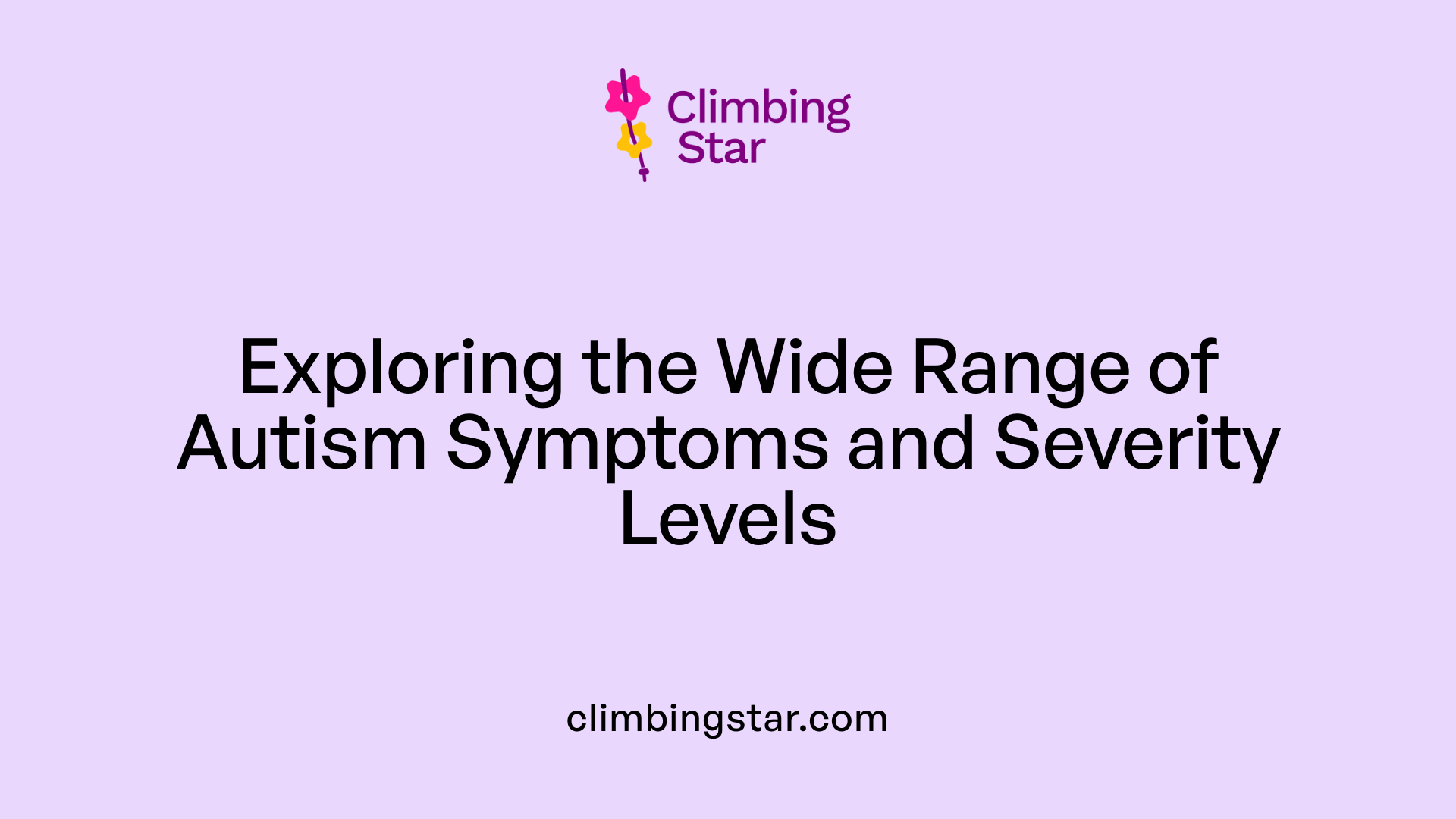
What are the characteristics and differences among autism subtypes such as Asperger's, autistic disorder, PDD-NOS, and Rett syndrome?
Autism spectrum disorder (ASD) encompasses a wide range of conditions that vary in severity, manifestation, and developmental course. Although these conditions share core features such as challenges in social interaction, communication difficulties, and repetitive behaviors, each subtype has distinct characteristics.
Asperger’s syndrome, now classified as Level 1 ASD in the DSM-5, is often considered the milder end of the spectrum. Individuals with Asperger’s typically have average or above-average intelligence, strong verbal skills, and can usually manage daily life routines independently. However, they often experience significant difficulties with social cues, understanding social norms, and forming peer relationships.
Autistic disorder, also known as classic autism, presents with more severe impairments. Symptoms usually appear before age 3 and include marked difficulties in social communication, such as limited eye contact, failure to respond to their name, and challenges in engaging with peers. Behavioral patterns include intense focus on specific interests, routines, and repetitive movements. This form often involves additional challenges like language delays and, in many cases, intellectual disabilities.
Pervasive Developmental Disorder Not Otherwise Specified (PDD-NOS) describes children who exhibit several autistic traits but do not meet the complete criteria for autistic disorder or Asperger’s syndrome. These individuals may have milder symptoms or atypical presentations, making diagnosis more complex. They might show social and communication difficulties but with less intensity or fewer behaviors.
Rett syndrome is a separate neurological disorder primarily affecting girls. It involves a period of normal development followed by regression, where children lose previously acquired skills such as speech and purposeful hand movements. Rett syndrome is caused by mutations in the MECP2 gene and is no longer classified as an ASD according to current diagnostic guidelines. Its features include severe motor impairment, seizures, and intellectual disability.
Differences in onset and progression are notable among these conditions. Asperger’s syndrome typically has a later onset with no significant language delay. Autistic disorder involves early onset, often with delays in speech and social skills. Rett syndrome begins with normal development, followed by decline, usually in early childhood.
Gender prevalence varies, with boys being diagnosed four times more often than girls, although symptoms in girls may be subtler, contributing to underdiagnosis.
Figure 1 illustrates the distinctions among these subtypes:
| Subtype | Typical Age of Onset | Severity Level | Main Characteristics | Associated Features |
|---|---|---|---|---|
| Asperger’s | Usually after age 3 | Mild (Level 1) | Strong language skills, social difficulties, focused interests | High intelligence, independent routines |
| Autistic Disorder | Before age 3 | Severe (Level 3) | Significant communication delays; repetitive behaviors; social impairments | Intellectual disabilities common |
| PDD-NOS | Variable | Mild to moderate | Atypical or milder symptoms; social and communication challenges | May not meet full criteria for other subtypes |
| Rett Syndrome | Often in infancy or early childhood | Severe | Regression after normal development; loss of purposeful hand use | Seizures, severe motor delays |
How do these distinctions impact diagnosis and intervention?
Understanding these variations helps clinicians tailor interventions suited to individual needs. For example, those with Asperger’s often benefit from social skills training, while children with autistic disorder might require more intensive behavioral therapies. Recognizing Rett syndrome as a distinct condition emphasizes the importance of genetic testing and specialized medical care.
Are there recent developments in characterizing autism subtypes?
Recent research by Princeton University and the Simons Foundation has identified four distinct autism subtypes based on behavioral and genetic profiles:
| Subtype | Primary Traits | Typical Development | Co-occurring Conditions | Genetic Profile |
|---|---|---|---|---|
| Social and Behavioral Challenges | Core social and behavioral deficits, typical milestones | Usually typical | ADHD, anxiety, depression, OCD | Damaging de novo mutations |
| Mixed ASD with Developmental Delay | Later milestones, mild symptoms | Delayed | Rarely shows psychiatric comorbidities | Rare inherited variants |
| Moderate Challenges | Less intense symptoms, typical milestones | Usually typical | Fewer psychiatric co-occurring conditions | Genetic influences vary |
| Broadly Affected | Extensive developmental and psychiatric challenges | Variable | Severe delays, multiple psychiatric conditions | Wide range of genetic mutations |
These findings illustrate that autism is not a single condition but a collection of diverse profiles, necessitating personalized intervention strategies.
Which factors influence the diagnosis of each subtype?
Multiple factors, including genetics, timing of symptom emergence, and severity, influence diagnosis. Early signs often include behaviors like limited eye contact, unusual speech patterns, and resistance to change. Because of subtle differences, especially in females, diagnosis can sometimes be delayed or overlooked.
Monitoring and understanding the spectrum enables better support, early intervention, and tailored therapies for each individual.
Genetics and Scientific Research in Autism Subtypes
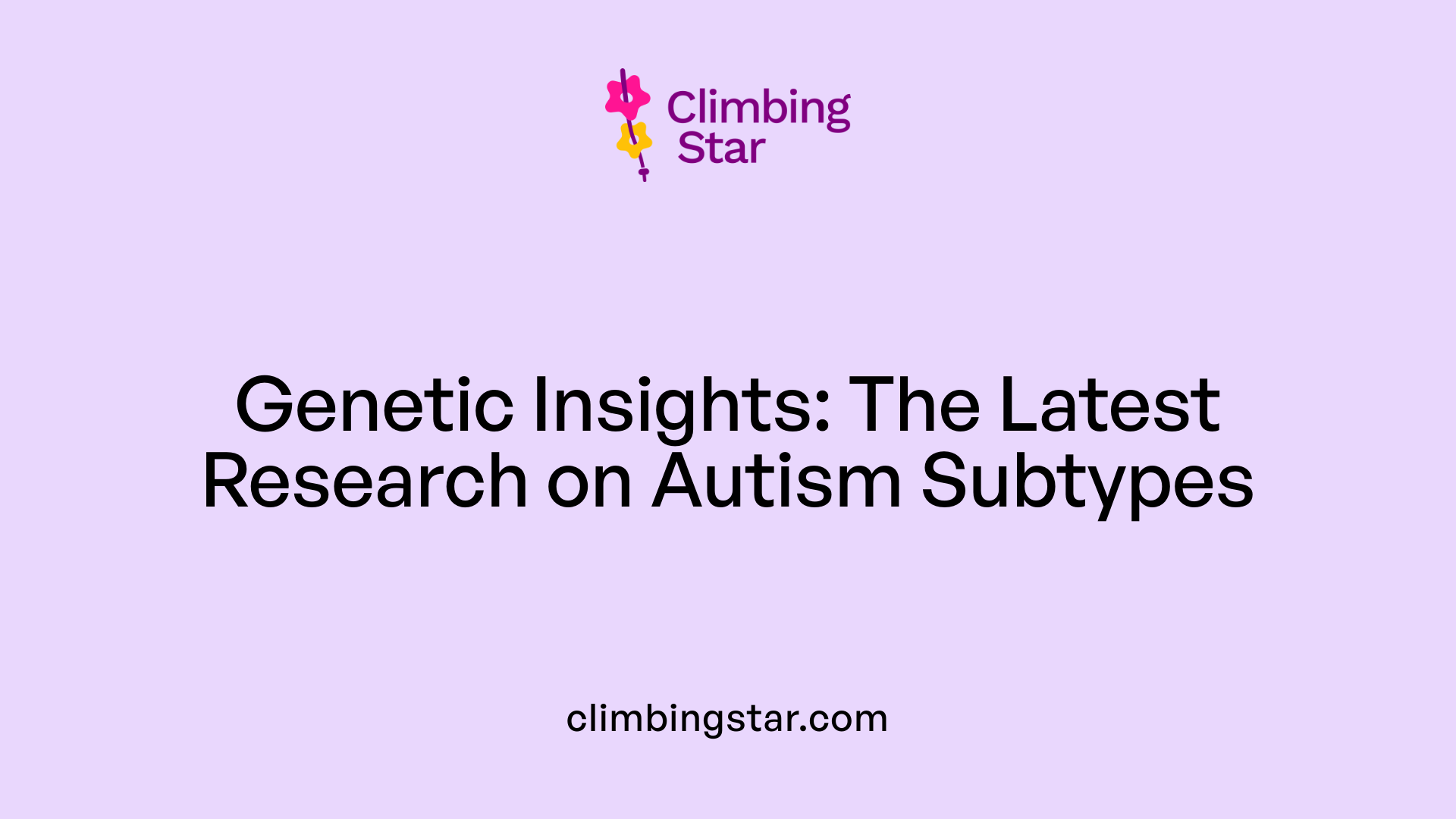
What is the latest scientific research on autism subtypes, including genetic research, and what are its implications for diagnosis and treatment?
Recent advances in autism research have shed new light on the biological diversity within the autism spectrum. A significant study, published in Nature Genetics, has identified four distinct subtypes of autism, each with unique behavioral, developmental, and genetic characteristics. These subtypes are: Social and Behavioral Challenges, Mixed ASD with Developmental Delay, Moderate Challenges, and Broadly Affected.
The study utilized cutting-edge genetic analysis techniques to map the genetic profiles associated with each subtype. It uncovered that these groups are linked to specific genetic variations. For example, the Broadly Affected subtype shows the highest incidence of damaging de novo mutations—new genetic changes that are not inherited but occur spontaneously. Conversely, the Mixed ASD with Developmental Delay group tends to carry rare inherited variants, indicating different genetic mechanisms at play.
These findings suggest that autism is not a single, uniform condition but rather a collection of biologically distinct subtypes. Each subtype appears to follow different developmental trajectories, with some genetic effects manifesting after birth. This discovery marks a paradigm shift in understanding autism, underpinning the importance of personalized approaches to diagnosis and intervention.
Implications for diagnosis include the potential for more precise classification tools that consider genetic profiles alongside behavioral symptoms. Such detailed subtyping can enable clinicians to better predict developmental outcomes and tailor support strategies early in life, improving overall prognosis.
Personalized treatment approaches grounded in genetic insights can target the specific biological pathways involved in each subtype. For example, therapies could be developed to address particular genetic mutations or signaling processes unique to each group, leading to more effective and targeted interventions.
This research also emphasizes the heterogeneity of autism, dispelling the myth of a singular cause or presentation. Recognizing multiple biological mechanisms offers hope for developing new medications and therapies that are more tailored to individual needs.
In summary, the integration of genetic research into autism diagnostics and treatment planning is transforming the field. The ability to categorize autism into distinct subtypes based on genetic and behavioral data fosters more nuanced understanding, early intervention, and personalized care, ultimately improving outcomes for many individuals on the spectrum.
| Autism Subtype | Genetic Profile | Developmental Traits | Associated Conditions |
|---|---|---|---|
| Social and Behavioral Challenges | Typical mutation levels, some co-occurring disorders | Milestones generally typical, autism traits present | ADHD, anxiety, depression |
| Mixed ASD with Developmental Delay | Rare inherited variants, less severe mutations | Early delays, later development of skills | Fewer psychiatric co-occurrences |
| Moderate Challenges | Fewer aggressive mutations, milder genetic impact | Milestones near typical, less severe behaviors | Rarely associated with additional conditions |
| Broadly Affected | Highest rate of damaging new mutations | Significant delays, wide-ranging impairments | High psychiatric and medical comorbidities |
This new genetic classification supports a more individualized approach to autism care, encouraging early, targeted intervention strategies aligned with each person's biological and behavioral profile. As research progresses, these insights promise to refine diagnostic criteria and improve support systems, optimizing outcomes for individuals with autism.
Associated Conditions and Comorbidities in Autism Spectrum Disorder
What conditions and disorders are often associated with autism spectrum disorder?
Autism spectrum disorder (ASD) is frequently found alongside a variety of physical and mental health conditions. These co-occurring issues can influence the severity and manifestation of autism, often requiring specialized treatment strategies.
Some of the most common associated conditions include:
- Gastrointestinal Problems: Many autistic individuals experience digestive issues such as constipation, diarrhea, or abdominal pain.
- Seizure Disorders: Epilepsy is more prevalent among those with ASD, especially in severe cases or those with certain genetic syndromes.
- Sleep Disturbances: Difficulties falling asleep, frequent night awakenings, and irregular sleep patterns are common.
- Feeding Issues: Some children show selectivity or aversion to certain textures or foods, leading to nutritional concerns.
Beyond these physical health issues, ASD is also linked with various neurodevelopmental and psychiatric disorders, including:
- Attention-Deficit/Hyperactivity Disorder (ADHD): Characterized by inattention, hyperactivity, and impulsivity, often co-occurring with ASD.
- Anxiety and Depression: Many individuals experience heightened anxiety or depression, especially as social demands increase.
- Obsessive-Compulsive Disorder (OCD): Repetitive behaviors and strict routines seen in autism can resemble OCD patterns.
- Schizophrenia and Bipolar Disorder: Although less common, some individuals may develop these mood or psychotic disorders.
Several genetic syndromes frequently associated with ASD include:
| Disorder | Prevalence in ASD Population | Main Features | Additional Notes |
|---|---|---|---|
| Down Syndrome | Up to 15% | Intellectual disability, characteristic facial features | May have ASD-like behaviors |
| Fragile X Syndrome | About 15-20% of males with Fragile X | Intellectual disability, speech delays, hyperactivity | Largest genetic cause of autism |
| Rett Syndrome | Mainly affects girls; 1 in 15,000 | Regression in language and motor skills, hand stereotypies | Caused by MECP2 gene mutations |
| Williams Syndrome | 1 in 7,500 to 10,000 | Heart defects, unique personality traits, hypersensitivity | Often exhibit social disinhibition |
| Tuberous Sclerosis | 30-50% of those with TSC | Tumors in multiple organs, seizures, developmental delays | May include autism-like symptoms |
It’s important to recognize that these conditions can impact the course and intervention strategies for ASD.
Overall, autism's coexistence with other medical and psychiatric conditions emphasizes the need for comprehensive assessment. Addressing these co-occurring disorders can improve quality of life and help tailor more effective support plans.
Unique Challenges and Support Strategies for Different Autism Subtypes
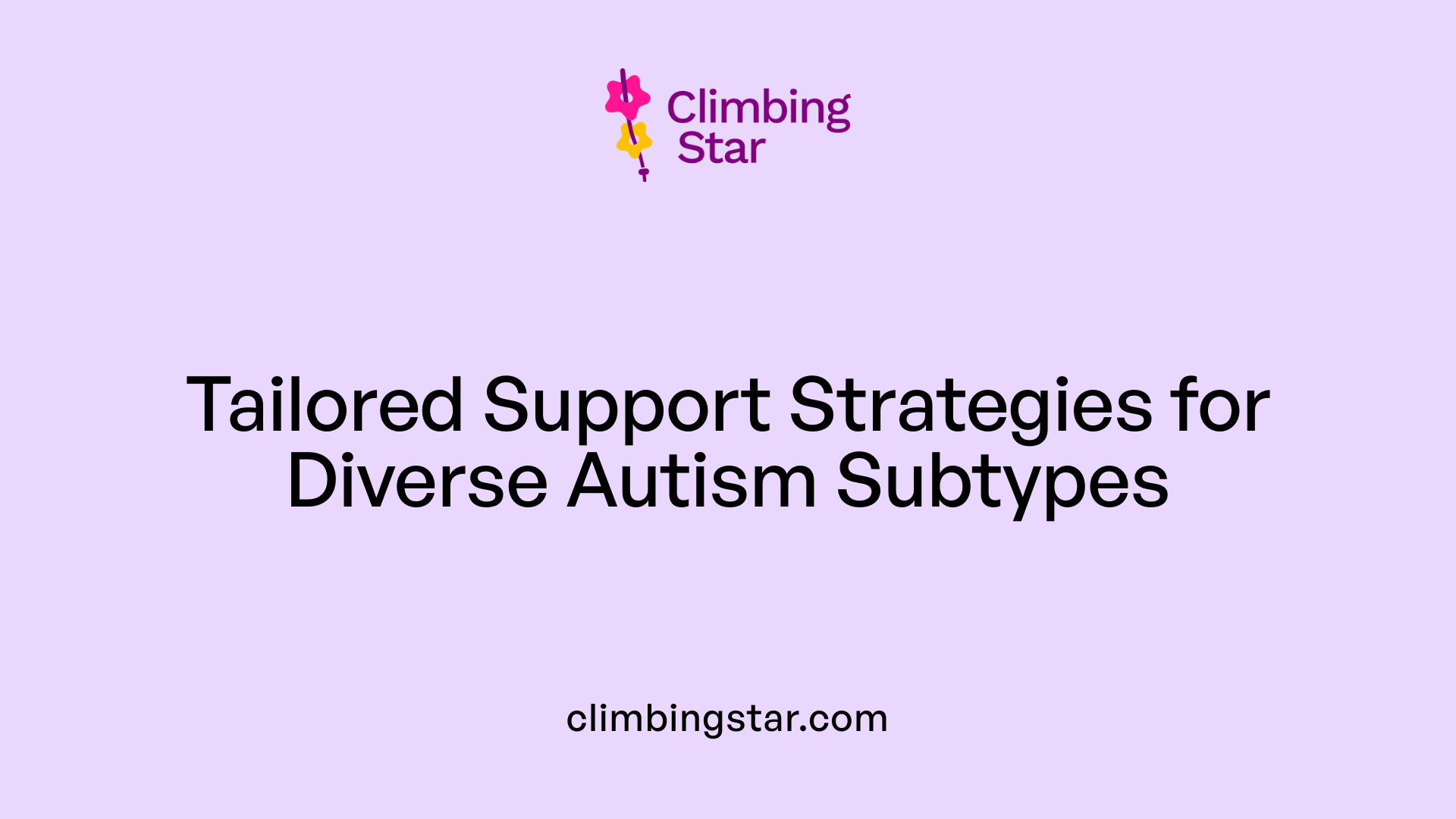
How have the diagnostic criteria for autism spectrum disorder evolved over time?
The diagnostic criteria for autism spectrum disorder (ASD) have undergone significant changes over the decades, reflecting a deepening understanding of autism as a spectrum rather than a single, uniform condition. Initially, autism was described within broader frameworks, often associated with childhood schizophrenia or as a distinct behavioral disorder. Early manuals like DSM-II emphasized behavioral abnormalities without specific criteria that captured the variability of autism.
The major shift occurred with DSM-III in 1980, which formally recognized autism as a specific pervasive developmental disorder (PDD) with clearer, more structured criteria. This set the stage for better identification and differentiation from other developmental issues. The DSM-IV further refined these definitions, delineating related conditions such as Asperger’s disorder, childhood disintegrative disorder, and PDD-NOS, each with distinct features but often overlapping symptoms.
A turning point came with DSM-5 in 2013, which streamlined these diagnoses into a single category called "autism spectrum disorder". This unified approach was based on the understanding that these conditions lie along a continuum with shared core features like challenges in social communication and repetitive behaviors. The DSM-5 introduced severity levels (1, 2, and 3), indicating the amount of support an individual might need.
More recently, DSM-5-TR (2022) has continued to fine-tune the diagnostic criteria, incorporating ongoing research to improve accuracy. It emphasizes observable behaviors, developmental history, and the need for support, aiming to minimize underdiagnosis, especially in females and individuals with milder forms.
These evolving criteria reflect advances in scientific research, greater awareness of developmental and cultural diversity, and a commitment to personalized diagnosis and treatment approaches. The shift towards a spectrum model allows clinicians to better understand the wide range of abilities and challenges faced by individuals with autism, enabling more targeted and effective interventions.
What are the differences among the autism subtypes identified by recent research?
Recent research has identified four distinct subtypes of autism based on clinical presentation and genetic profiles. These subtypes help explain the diversity of experiences among individuals on the spectrum.
| Subtype | Characteristics | Developmental Pattern | Associated Conditions | Underlying Genetics |
|---|---|---|---|---|
| Social and Behavioral Challenges | Core autism traits like social difficulties, repetitive behaviors. Development milestones typically reached on time. | Typical development in most areas. | ADHD, anxiety, depression, OCD. | Varied, with less genetic damage observed. |
| Mixed ASD with Developmental Delay | Later than typical developmental milestones; some signs of autism are present. | Delays in speech, motor skills, and social development. | Usually no significant psychiatric comorbidities. | Rare inherited genetic variants. |
| Moderate Challenges | Milder autism traits, fewer co-occurring conditions. | Milestones reached on schedule or slightly delayed. | Less common psychiatric comorbidities. | Mix of inherited and de novo mutations. |
| Broadly Affected | Severe challenges across multiple domains, including delays and psychiatric issues. | More widespread developmental delays. | High prevalence of genetic mutations, including damaging de novo mutations. | Highest levels of genetic damage, including de novo mutations. |
These subtypes are associated with different genetic profiles and developmental trajectories, indicating that autism involves various biological mechanisms. Understanding these differences allows researchers and clinicians to tailor interventions more effectively.
Why is understanding the heterogeneity among autism subtypes important?
Recognizing the diversity among autism subtypes is crucial because each presents unique challenges and strengths. Personalized treatment plans are more effective when based on the specific subtype, genetic factors, and developmental history.
For example, individuals with Social and Behavioral Challenges often benefit from social skills training and behavioral therapies, while those in the Broadly Affected group may require more intensive, multidisciplinary support. Those with developmental delays might benefit from early speech and occupational therapy,
How does support differ among autism subtypes?
Support strategies vary considerably among subtypes to address specific needs:
- Social and Behavioral Challenges: Focus on social skills development, behavioral therapy, and behavioral modifications.
- Mixed ASD with Developmental Delay: Emphasize early intervention to improve developmental milestones and prevent secondary issues.
- Moderate Challenges: Support with skill building, community integration, and mental health support.
- Broadly Affected: Intensive, individualized interventions, including specialized educational programs, medical support, and mental health therapies.
Understanding these distinctions helps caregivers, educators, and clinicians to implement effective, personalized strategies. It also guides research efforts towards uncovering the precise biological mechanisms, paving the way for targeted therapies.
| Aspect | Subtype | Support Strategies | Typical Challenges | Unique Needs |
|---|---|---|---|---|
| Core Symptoms | Social/Behavior | Behavioral therapies, social skills training | Social difficulties, repetitive behaviors | Focused on social interaction and routine support |
| Developmental Delay | Delays in milestones | Early intervention, speech, and occupational therapy | Speech delay, motor skill deficits | Time-sensitive support, developmental tracking |
| Mild / Moderate Challenges | Less severe symptoms | Skill development, community engagement | Mild social or behavioral issues | Flexible, supportive environments |
| Severe / Broadly Affected | Extensive delays and challenges | Multidisciplinary, intensive support | Developmental regression, psychiatric issues | Highly personalized, ongoing care |
Development of Personalized and Subtype-Specific Interventions
What is the latest scientific research on autism subtypes, including genetic research, and what are its implications for diagnosis and treatment?
Recent breakthroughs in autism research have revealed that the condition is not a single, uniform disorder but comprises several distinct subtypes with unique biological and behavioral profiles. A notable study, published in Nature Genetics, identified four primary autism subtypes: Social and Behavioral Challenges, Mixed ASD with Developmental Delay, Moderate Challenges, and Broadly Affected.
Each of these categories exhibits specific genetic patterns that help explain their differences. For example, the Broadly Affected group shows the highest rate of damaging de novo mutations—new genetic changes not inherited from parents—indicating more extensive genetic disruptions. In contrast, the Mixed ASD with Developmental Delay group is more often associated with rare inherited genetic variants.
These genetic distinctions are crucial because they suggest multiple biological pathways leading to autism. Recognizing this diversity shifts the focus from a one-size-fits-all approach to more precise, individualized treatments.
Understanding the genetic and behavioral profiles of each subtype has important implications:
- Refining diagnosis: Early identification of a child's subtype can lead to more targeted support.
- Tailored interventions: Treatments can be customized based on the specific biological and behavioral characteristics, potentially improving outcomes.
- Enhanced developmental monitoring: Knowing the biological basis can guide clinicians in tracking development more effectively.
The research underscores that autism encompasses multiple genetic factors that influence the course of the disorder. Some subtypes display genetic effects that manifest after birth, further emphasizing the need for ongoing assessment and personalized planning.
This scientific progress is paving the way for the era of precision medicine in autism care. Instead of generic support, clinicians can develop interventions grounded in a child’s unique genetic and behavioral profile, thus maximizing developmental gains and quality of life.
How does understanding genetic differences in autism influence diagnosis and treatment?
| Autism Subtype | Genetic Profile | Treatment Implication | Developmental Features | Additional Notes |
|---|---|---|---|---|
| Social and Behavioral Challenges | Typical development with possible co-occurring conditions | Support for social skills, behavioral therapies | Typical milestone achievement, co-existing ADHD, anxiety | Often reaches milestones on time but struggles socially |
| Mixed ASD with Developmental Delay | Rare inherited variants, later developmental milestones | Focus on developmental delays, early intervention | Delayed milestones, less associated with psychiatric conditions | Usually diagnosed later due to delayed milestones |
| Moderate Challenges | Fewer severe genetic disruptions | Less intensive therapies, social skills support | Near-normal developmental trajectory | Less severe autism-related behaviors |
| Broadly Affected | Highest rate of damaging de novo mutations | Specialized, intensive therapy programs | Significant developmental delays, wide-ranging challenges | Often linked with comorbid psychiatric issues |
Future Directions
Researchers continue to explore the genetic underpinnings of autism, aiming to identify biological markers for even more precise subclassification. The goal is to develop highly personalized treatment plans that acknowledge the complex origins of each individual's condition.
This evolving understanding promises a future where autism diagnosis and intervention are deeply tailored, potentially transforming outcomes for many individuals by aligning support strategies with their unique genetic and developmental profile.
Towards a More Personalized Future in Autism Care
The diversity within autism spectrum disorder highlights the importance of individualized approaches to diagnosis, intervention, and support. Advances in genetic research have begun to unravel the biological complexity underlying different subtypes, paving the way for more precise, targeted treatment options. Recognizing the spectrum's true breadth ensures that each person receives the appropriate level and type of support, maximizing their strengths and addressing their unique challenges. As ongoing research continues to deepen our understanding, the future of autism care lies in personalized strategies that respect each individual’s developmental trajectory and biological profile, fostering better outcomes and quality of life for all.
References
- What Are the Types of Autism Spectrum Disorders?
- What Are the 5 Different Types of Autism?
- Autism spectrum disorder (ASD)
- Autism spectrum disorder - Symptoms and causes
- 7 Disorders Closely Related to Autism
- Autism spectrum disorders - PMC
- Major autism study uncovers biologically distinct subtypes, ...
- Autism diagnostic criteria: DSM-5







